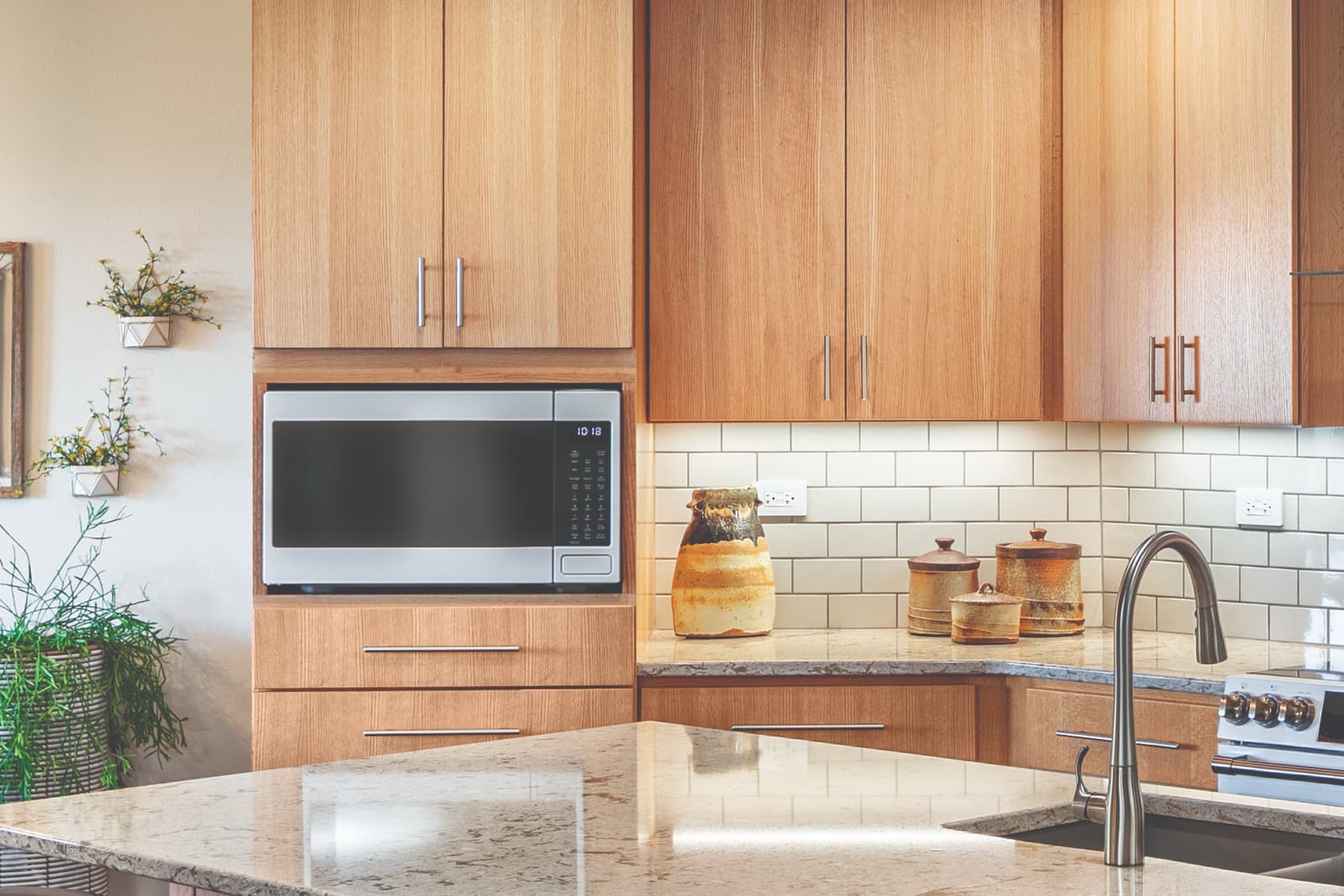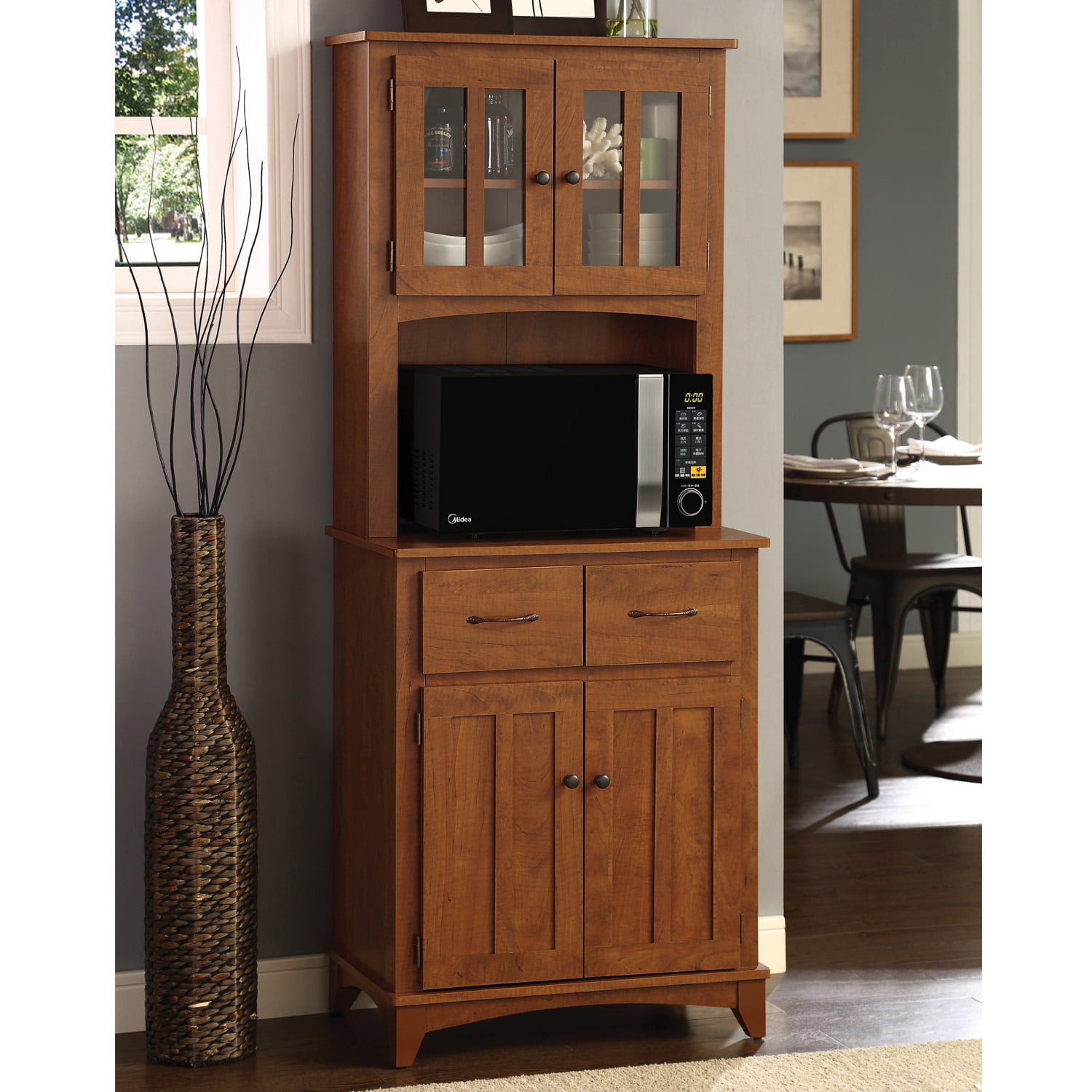The Benefits of a Pantry Cabinet with Built-in Microwave

A pantry cabinet with a built-in microwave offers a seamless blend of convenience, space-saving efficiency, and enhanced aesthetics for your kitchen. By integrating the microwave into the pantry, you create a streamlined and functional design, maximizing space while eliminating the need for a separate countertop appliance.
Convenience and Space-Saving, Pantry cabinet with built in microwave
A built-in microwave eliminates the need for dedicated counter space, freeing up valuable real estate for other kitchen tasks or appliances. This is particularly beneficial in smaller kitchens where every inch counts. The integrated design also allows for a more organized and clutter-free countertop, enhancing the overall visual appeal of the kitchen.
Design Considerations for Pantry Cabinets with Built-in Microwaves: Pantry Cabinet With Built In Microwave

Integrating a microwave into a pantry cabinet requires careful planning to ensure optimal functionality and accessibility. This involves considering the cabinet’s size, placement, and the microwave’s specifications.
Cabinet Size and Placement
The size and placement of the pantry cabinet are crucial for maximizing its usability and accessibility.
- Cabinet Depth: The cabinet should be deep enough to accommodate the microwave comfortably, leaving enough space for ventilation and ease of access. A minimum depth of 24 inches is recommended for most standard microwaves.
- Cabinet Width: The width of the cabinet should be sufficient to accommodate the microwave and any additional storage space. Consider the size of the microwave and the amount of pantry storage you need. For a standard microwave, a cabinet width of 30 inches is a good starting point.
- Cabinet Height: The height of the cabinet should be suitable for comfortable use of the microwave. The bottom of the microwave should be at a height that allows for easy access and prevents strain. A height of 36-42 inches is typically ideal for most people.
- Placement: Consider the location of the pantry cabinet in relation to other appliances and workspaces. Place the cabinet in a location that is easily accessible and convenient for daily use.
Microwave Size and Power Level
Choosing the right microwave size and power level is essential for meeting your individual needs.
- Microwave Size: Consider the size of the microwave based on your household’s needs. A larger microwave may be necessary for families who frequently reheat large meals or use it for cooking. Smaller microwaves are suitable for individuals or smaller families.
- Microwave Power Level: The power level of a microwave determines how quickly it can heat food. A higher wattage microwave will heat food faster. Consider the frequency of use and the types of food you plan to reheat or cook. For frequent use and heating larger quantities, a higher wattage microwave is recommended. For occasional use and reheating smaller portions, a lower wattage microwave may be sufficient.
Ventilation
Proper ventilation is crucial to prevent overheating and ensure the safe operation of the microwave.
- Airflow: Ensure adequate airflow around the microwave to prevent overheating. Leave at least 2-3 inches of space between the microwave and any surrounding walls or cabinet surfaces.
- Ventilation System: Consider incorporating a ventilation system into the pantry cabinet. This can be a simple exhaust fan or a more elaborate system that vents directly to the exterior. Adequate ventilation is particularly important if the microwave is located in a small or enclosed space.
Installation and Maintenance of Pantry Cabinets with Built-in Microwaves

Installing a pantry cabinet with a built-in microwave is a relatively straightforward process, but it does require some planning and expertise. Proper maintenance ensures the longevity and efficiency of your appliance.
Installation Process
The installation process involves several steps, including preparing the space, connecting the microwave to the power supply, and ensuring proper ventilation.
- Preparing the Space: The first step is to determine the ideal location for the pantry cabinet with the built-in microwave. Consider factors such as proximity to existing electrical outlets, plumbing, and ventilation. Ensure that the cabinet’s dimensions are compatible with the chosen location. You might need to modify the existing cabinetry or walls to accommodate the cabinet.
- Electrical Wiring: Connecting the microwave to the power supply is crucial. Consult an electrician to ensure the wiring meets the microwave’s power requirements. The microwave will need a dedicated electrical circuit with a suitable amperage. A standard 15-amp circuit is usually sufficient for most microwaves, but larger models may require a 20-amp circuit.
- Ventilation: Adequate ventilation is essential for preventing overheating and ensuring safe operation. Ensure the cabinet has sufficient ventilation openings to allow heat to escape. The ventilation should be located in a way that doesn’t obstruct airflow. Consider using a vent fan to improve ventilation, especially in small or poorly ventilated spaces.
- Plumbing Considerations: While most microwaves do not require plumbing connections, some models may have a built-in water dispenser. If you are installing a microwave with a water dispenser, you will need to connect it to a cold water supply and a drain line. Consult a plumber to ensure the installation is done correctly and meets local plumbing codes.
- Securing the Cabinet: Once the electrical wiring and ventilation are in place, you can secure the cabinet to the wall or surrounding cabinetry. Use appropriate screws and brackets to ensure the cabinet is firmly fixed and stable.
Maintenance Tips
Regular maintenance is crucial for keeping your built-in microwave clean and operating efficiently.
- Cleaning the Microwave: Regular cleaning helps prevent the buildup of food particles and grease. Clean the interior and exterior of the microwave using a mild soap and water solution. Avoid using abrasive cleaners, as they can damage the microwave’s finish.
- Ensuring Proper Ventilation: Regular checks are essential to ensure the ventilation system is working correctly. Remove any obstructions from the ventilation openings and ensure the vent fan is operating properly.
- Checking the Power Cord: Regularly inspect the power cord for any signs of damage, such as cracks or fraying. Replace a damaged power cord immediately to prevent electrical hazards.
- Troubleshooting Issues: If you experience any issues with your built-in microwave, such as a lack of power, unusual noises, or a failure to heat, try troubleshooting the problem. Refer to the microwave’s user manual for specific troubleshooting tips. If you cannot resolve the issue, contact a qualified appliance technician.
Potential Issues and Troubleshooting Tips
While built-in microwaves are generally reliable, some potential issues may arise.
- Lack of Power: If the microwave is not powering on, check the power outlet, circuit breaker, and power cord for any issues. Ensure the microwave is plugged in properly and that the circuit breaker is not tripped.
- Unusual Noises: If the microwave is making unusual noises, such as buzzing or clicking, it could indicate a problem with the motor or fan. Check the user manual for troubleshooting tips or contact a technician for repair.
- Failure to Heat: If the microwave is not heating properly, check the fuse or circuit breaker. Ensure the microwave door is closing securely, as a faulty door seal can prevent proper heating.
- Overheating: If the microwave is overheating, check the ventilation system to ensure it is not obstructed. Ensure the microwave is not overloaded with food.
Pantry cabinet with built in microwave – A pantry cabinet with a built-in microwave is a fantastic way to maximize space in your kitchen, especially if you’re short on counter space. But if you’re looking for a more rustic aesthetic, a rustic wood storage cabinet can add warmth and character to your space.
And while it might not have a built-in microwave, you can always add a countertop model or even a microwave cart to complete your rustic kitchen setup.
A pantry cabinet with a built-in microwave is a fantastic way to streamline your kitchen, but don’t forget about the importance of storage in other areas of your home. If you’re looking for a stylish and functional way to organize your bathroom essentials, consider bathroom medicine cabinets espresso – they offer a sleek look and ample space for all your toiletries.
Just like a well-organized pantry, a well-designed bathroom cabinet can make a world of difference in your daily routine.
